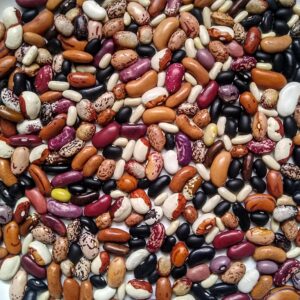
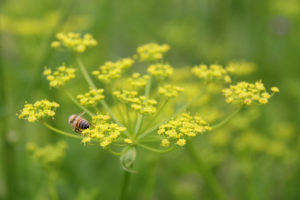
Pollinators are an essential partner in our work to build healthy, organic seed systems that support biodiversity and provide high-quality seed. The focus on pollinators this week is a helpful reminder that the dramatic and ongoing decline in pollinators – both commercially managed as well as native species – threatens not just the viability of organic seed producers but food security itself, since most of the food crops we eat everyday require pollination. Since the mid-1950s, the number of commercially managed honey bee hives in the U.S. has declined by nearly 50%. Yet, in the same timeframe, the amount of U.S. crop acreage requiring bee pollination has nearly doubled.
We all have a role to play in protecting our pollinators. Tell Congress today to support the Save America’s Pollinators Act, which calls for the suspension of bee-killing pesticides until a full review of scientific evidence indicates they are safe and a field study demonstrates they do no harm to bees and other pollinators. The European Union has already placed a two-year ban on many of the most harmful pesticides in an effort to protect pollinators, but the U.S. Environmental Protection Agency has delayed action until 2018. Call on Congress to require swifter action.
And if you’re a seed producer, check out Pollinator Management for Organic Seed Producers, a publication that Organic Seed Alliance co-published with the Xerces Society earlier this year. It’s a timely resource that provides detailed overviews of the role and diversity of seed crop pollinators and strategies for managing pollination, including crop-specific guidelines. The publication also includes profiles of common pollinators and strategies for reducing pollen movement between organic and conventional farms, including farms growing genetically engineered crops. Read on for an excerpt from this publication. Download the full version here.
Pollinator Management for Organic Seed Producers
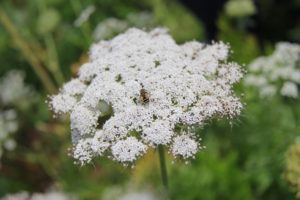
More than 80% of the world’s flowering plants depend upon insect pollinators to produce seed; this includes more than two thirds of all agricultural species. Because of this, bees and other pollinators are of obvious importance to producers.
Organic seed producers may be particularly interested in the role of pollinators, especially when confronted by the risk of genetic contamination of their crops (such as by the accidental movement of genetically modified crop pollen). Understanding the role and diversity of seed crop pollinators, and strategies for reducing pollen movement between organic and conventional farms, can help ensure the survival of a robust organic seed industry.
Why Care About Pollinator Management?
Since the mid-1950s, the number of commercially managed honey bee hives in the United States has declined by nearly 50%. The accidental introduction of various honey bee diseases and parasites, as well as habitat loss, pesticide use, and other factors have all contributed to this trend. Despite this decline, in the same timeframe, the amount of U.S. crop acreage requiring bee pollination has nearly doubled.
While the decline of honey bees has been widely reported, less attention has been paid to similar declines of our native bee species, including our bumble bees, several of which are now believed to be teetering on the brink of extinction. By incorporating pollinator conservation into an organic farm system, growers can play a meaningful role in helping to reverse these trends.
Pollinator conservation can also help farmers fulfill the biodiversity requirements for organic certification described in the National Organic Program (NOP) rule. For example, the NOP definition of organic farming includes practices that:
“Foster cycling of resources, promote ecological balance, and conserve biodiversity” (§205.2) and “Maintain or improve the natural resources—the physical, hydrological, and biological features, including soil, water, wetlands, woodlands, and wildlife—of the operation” (§205.200 and §205.2)
Pollinator conservation provides a convenient framework for meeting these requirements, and can provide secondary benefits to soil and water protection. It can also enhance pest control through the protection of beneficial insects that prey upon crop pests.
How Does Pollinator Management Impact Crop Genetics?
Effective seed-crop pollination can be a delicate balancing act between limiting undesirable outcrossing of different crop varieties while ensuring extensive pollen transfer between the desired populations of plants.
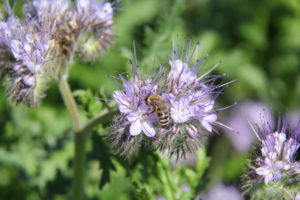
Undesirable outcrossing can occur when pollen is carried by the wind or bees into a seed crop field from an outside source. In some cases that outside source may simply be another compatible organic seed crop. For example, two different organic squash varieties growing in close proximity may cross when bees move pollen between their flowers. While the resulting seed would have two organic parents, the crossing of their genetics would produce a new squash variety that may not be desirable.
In other cases, undesirable outcrossing can occur when wind or bees move pollen between a genetically modified crop field and an organic seed crop. For example, if an herbicide-resistant alfalfa field is planted near an organic alfalfa seed field, bees may move pollen between the crops. For the organic seed producer, this could mean a seed crop that carries the genetically modified trait.
It is important to note that seed crops are often broadly categorized as either wind-pollinated or insect-pollinated. However, sometimes the lines between these two categories are blurred. For example, bees, especially honey bees, will sometimes collect pollen from plants such as corn that are considered to be wind-pollinated. This blurring of lines should be considered when factoring isolation distances (described later) between different crop varieties. Similarly, the potential for pollen contamination through the movement of beekeeping equipment is unknown, but should be considered for some crops (see the discussion of alfalfa leafcutter bees later in this publication).
While outcrossing between different seed fields can be problematic, insufficient pollen movement within a single crop variety can also create problems. For example, a few seed crops are self-incompatible, meaning they require pollen from another plant to produce seed.
Many seed crops are susceptible to inbreeding depression. Inbreeding depression can cause plants to produce less pollen, less seed, and less vigorous offspring when self-pollinated or crossed with plants that are too closely related. Plants will usually produce more vigorous offspring and more bountiful seed crops when cross-pollinated with genetically distinct individuals within the population. Onions, for example, are a crop that is commonly considered susceptible to inbreeding depression. In one study, onion seed produced through cross-pollination between neighboring plants had more than 75% seedling survival when planted in the field, compared with less than 50% seedling survival when the seed was produced through self-pollination.
For insect-pollinated crops that are either self-incompatible, or are susceptible to inbreeding-depression, it is critical to ensure that large numbers of pollinators are present to move pollen between flowers.
Bee Behavior and Crop Pollination
For most vegetable and agronomic seed crops, bees are the most important pollinators. Adult bees feed on nectar. However, unlike other insects that visit flowers exclusively for nectar (such as butterflies), bees actively collect pollen as the primary food source for their larvae. In the process of visiting flowers for pollen and nectar, bees accidentally drop large quantities of pollen grains wherever they go.
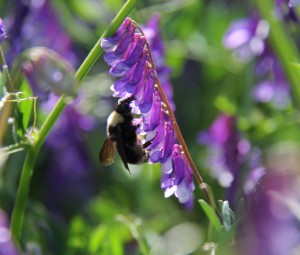
Bees are also among the few groups of insects that establish nests for their larvae. In the case of honey bees, that nest is a hive filled with wax combs that contain eggs and developing brood, while bumble bees in contrast, tend to create a small cluster of wax pots to hold their eggs in an insulated cavity (such as an old rodent burrow). Solitary bees, such as sweat bees, tunnel into the ground and lay eggs in a series of dead-end chambers provisioned with pollen. Because of this nesting habit, bees tend to stay in a particular area, spending the days enlarging their nest, laying eggs, and collecting pollen to feed their offspring. Consequently bees tend to visit the same nearby plants over and over again. Seed crop producers can take advantage of this foraging range by either placing a honey bee hive in the field—ensuring adequate crop pollination in close proximity to the hive—or a producer can implement conservation practices that protect resident wild bee populations that can deliver that same (and in some cases, better) pollination service.
Finally, unlike some flower-visiting insects, bees exhibit a behavior called floral constancy, meaning they visit the same flower species in succession. This important behavior means that bees will continue to visit the same type of flower repeatedly for a given period of time, ensuring cross-pollination within the same species. For example, bees collecting squash pollen will typically continue to visit squash flowers for a number of minutes or hours, repeatedly spreading pollen between them. The presence of sunflowers or other blooming plants nearby will not entice the bees away from squash until they are ready to visit those sunflowers in repeated succession. Bees make these switches between different flower species based upon the quality and availability of pollen and nectar. Many plants will provide more nectar or pollen at particular times of day, or on a single day within their bloom period. Bees are constantly checking these resources in their environment, and selecting the most rewarding ones at a given moment to harvest.
Download the full version of Pollinator Management for Organic Seed Producers here.
